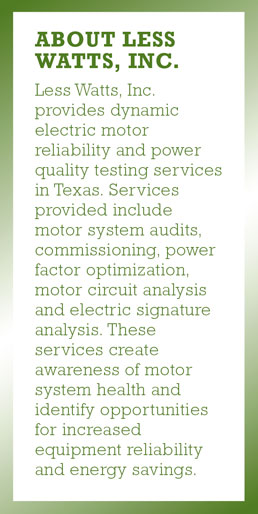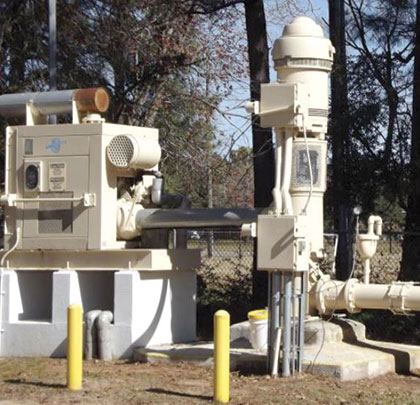Unlike residential consumers, industrial and commercial companies are required to pay for the reactive KVA demand power along with the active KW energy consumed. Each electrical power provider supplies reactive KVA used to produce the magnetic field in the motor that turns the rotor. The rotor converts electrical energy into mechanical energy that drives connected rotating equipment. The KVA electrical power is not consumed like the active KW energy. Utility providers use a demand meter to determine how efficiently a customer is using the supplied KVA energy. The efficiency is measured as percentage below 1.0 or Unity. Power Factor (PF) below 95 percent has a penalty charge applied to each billing cycle. The monthly electric demand charges can be the major electrical charge for larger motors operating with low power factors. Companies who have optimized power factor and avoid PF penalties often achieve a return on investment (ROI) within two years.
In 2008, a Municipal Utility District (MUD) located in Texas began working with Less Watts, Inc., a company that specializes in motor reliability and power quality testing for the water/wastewater industry. At a MUD Board of Directors meeting, Stephen Hogue, president of Less Watts, Inc., discussed potential opportunities to improve rotating equipment operating efficiency and lower electrical costs. During 2009, capacitors were installed on eight of the larger District motors. Power quality monitoring for the Lift Station-1 during 2009 showed major reductions. By the end of 2009, the KVA billed was reduced 50 percent and KW was reduced 25 percent.
The 400 horsepower Well-1 motor with four 60 horsepower booster pumps did not indicate any energy cost reductions even though the power factor had been increased to 98 percent efficiency. As a solutions provider, Hogue contracted a third-party motor testing company to perform energized and de-energized testing at the Well-1 Facility. The testing revealed that two of the six underground motor cables which connected the well to the motor control center had been close to grounding out.

Well-1 pump motor tested with the ALL-TEST Pro 33 IND™
Immediate action was taken to re-trench and replace the 100-foot long lead cables that ran underground from the pump motor to the motor control center. At that point, Hogue knew it would be essential to collect and trend data on all the motors so he could better understand the health of the motors and show the MUD how the condition of their motors and other rotating equipment affected the MUD’s ability to achieve energy savings.
After extensive research of motor testing equipment, Less Watts Inc. purchased both the ALL-TEST Pro On-Line II™ and the ALL-TEST Pro 33 IND™. Both of these instruments are ideal for Condition Based Monitoring and trending. Less Watts Inc. chose these user friendly motor testing instruments for the following reasons:
The ATPOL II™ is used in energized conditions for both Electric Signature Analysis (ESA) and Power Quality Analysis (PQ). In ESA mode, the ATPOL II™ evaluates the condition of incoming power, the control circuit, the motor, and the driven load. When in PQ mode, it can be used for energy data logging for an array of data points that include harmonic analysis, voltage and current charting, viewing waveforms, waveform capture of sags and swells, transient event capture.
The AT33 IND™, which is used for de-energized testing, is specifically designed for troubleshooting motors and commissioning new and rebuilt motors before installation. The AT33 IND™ enables the operator to identify motor conditions that include winding contamination, stator and rotor unbalance, changes in rotor and stator condition, resistance in windings, contamination, and insulation to ground. This de-energized motor testing instrument reveals actual motor conditions and enables the scheduling of remedial work to prevent serious damage and even avoid catastrophic failure.
ALL-TEST Pro provided extensive training and support for Less Watts Inc. Stephen Hogue quickly learned how to use the motor testing instruments and immediately began trending data for the MUD motors. The AT33 IND™ proved to be instrumental in 2012 when the District’s 400 horsepower Well-1 pump motor was sent to a motor repair shop to be reconditioned.
“It is important to commission new and reconditioned motors. Without motor commissioning, there is no confirmation that the motor is going to operate as designed,” explains Hogue. “By commissioning the motor, the chance that a motor will have operational issues that appear after installation can be reduced. The owner is better off having a motor commissioned before paying for delivery and installation prior to finding out there is a problem. Finding issues after motor installation often leads to the owner having to fight for warranty satisfaction.”

When Hogue went to the motor repair shop to commission the reconditioned motor, the AT33 IND™ tests indicated poor insulation-to-ground results, showing a reading of 6.01 Mohm. A healthy reading for a reconditioned motor should have been between the range of 500 to 999 Mohm. The motor repair shop agreed to correct the issue. Hogue returned three days later to repeat the commissioning tests. Using the AT33 IND™, the test results indicated an insulation-to-ground read of 551 Mohm. Hogue issued his approval for the Well-1 Pump Motor to be shipped back to the lift station. Once the rebuilt vertical pump and reconditioned motor were installed, Hogue returned to the lift station to perform motor tests with the ATPOL II™ and the AT33 IND™ instruments. This time all tests yielded positive results, completing Hogue’s commissioning process. Today, the MUD’s Well-1 pump motor is operating efficiently, with an insulation-to-ground read at 999 Mohm and the Power Factor at 98 percent efficiency.
One key concept demonstrated by this MUD’s approach to motor reliability testing is that there is a change occurring in the industry. Equipment owners and operating service companies are improving their reactive maintenance strategies and are now embracing more condition based monitoring programs. This growing proactive change is increasing the benefits related to reduced downtime, energy savings, and extended equipment life cycles which are becoming more important for daily operations.
While providing dedicated personnel to monitor and trend collected electric motor data is difficult for most businesses, there are third-party professionals working to support the industry with condition based technologies. The ALL-TEST Pro 33 IND™ and the ALL-TEST Pro On-Line II™ instruments give end users the data they need to really understand the health of their equipment and to make informed decisions. ◆
ALL-TEST Pro, LLC, provides state-of-the-art instruments for troubleshooting, quality control and predictive maintenance of electric motors, transformers and generators. They offer a full line of testing instruments, software, accessories, and training programs to equip users with tools and expertise to perform advanced non-destructive motor testing and analysis for both de-energized motor circuit analysis and energized electrical signature analysis.
____________________________________________
MODERN PUMPING TODAY, July 2017
Did you enjoy this article?
Subscribe to the FREE Digital Edition of Modern Pumping Today Magazine!
![]()


